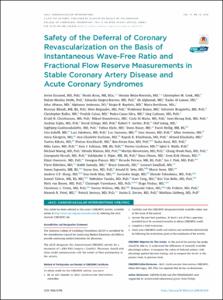KUMEL Repository
1. Journal Papers (연구논문)
1. School of Medicine (의과대학)
Dept. of Internal Medicine (내과학)
Safety of the Deferral of Coronary Revascularization on the Basis of Instantaneous Wave-Free Ratio and Fractional Flow Reserve Measurements in Stable Coronary Artery Disease and Acute Coronary Syndromes
- Keimyung Author(s)
- Nam, Chang Wook
- Department
- Dept. of Internal Medicine (내과학)
- Journal Title
- JACC: Cardiovascular Interventions
- Issued Date
- 2018
- Volume
- 11
- Issue
- 15
- Abstract
- OBJECTIVES
The aim of this study was to investigate the clinical outcomes of patients deferred from coronary revascularization on the basis of instantaneous wave-free ratio (iFR) or fractional flow reserve (FFR) measurements in stable angina pectoris (SAP) and acute coronary syndromes (ACS).
BACKGROUND
Assessment of coronary stenosis severity with pressure guidewires is recommended to determine the need for myocardial revascularization.
METHODS
The safety of deferral of coronary revascularization in the pooled per-protocol population (n ¼ 4,486) of the DEFINE-FLAIR (Functional Lesion Assessment of Intermediate Stenosis to Guide Revascularisation) and iFR-SWEDEHEART (Instantaneous Wave-Free Ratio Versus Fractional Flow Reserve in Patients With Stable Angina Pectoris or Acute Coronary Syndrome) randomized clinical trials was investigated. Patients were stratified according to revascularization decision making on the basis of iFR or FFR and to clinical presentation (SAP or ACS). The primary endpoint was major adverse cardiac events (MACE), defined as the composite of all-cause death, nonfatal myocardial infarction, or unplanned revascularization at 1 year.
RESULTS
Coronary revascularization was deferred in 2,130 patients. Deferral was performed in 1,117 patients (50%) in the iFR group and 1,013 patients (45%) in the FFR group (p < 0.01). At 1 year, the MACE rate in the deferred population was similar between the iFR and FFR groups (4.12% vs. 4.05%; fully adjusted hazard ratio: 1.13; 95% confidence interval: 0.72 to 1.79; p ¼ 0.60). A clinical presentation with ACS was associated with a higher MACE rate compared with SAP in deferred patients (5.91% vs. 3.64% in ACS and SAP, respectively; fully adjusted hazard ratio: 0.61 in favor of SAP; 95% confidence interval: 0.38 to 0.99; p ¼ 0.04).
CONCLUSIONS
Overall, deferral of revascularization is equally safe with both iFR and FFR, with a low MACE rate of about 4%. Lesions were more frequently deferred when iFR was used to assess physiological significance. In deferred patients presenting with ACS, the event rate was significantly increased compared with SAP at 1 year. (J Am Coll Cardiol Intv 2018;11:1437–49) © 2018 The Authors. Published by Elsevier on behalf of the American College of Cardiology Foundation.
- Keimyung Author(s)(Kor)
- 남창욱
- Publisher
- School of Medicine (의과대학)
- Citation
- Javier Escaned et al. (2018). Safety of the Deferral of Coronary Revascularization on the Basis of Instantaneous Wave-Free Ratio and Fractional Flow Reserve Measurements in Stable Coronary Artery Disease and Acute Coronary Syndromes. JACC: Cardiovascular Interventions, 11(15), 1437–1449. doi: 10.1016/j.jcin.2018.05.029
- Type
- Article
- ISSN
- 1876-7605
- Source
- https://www.sciencedirect.com/science/article/pii/S1936879818311439?via%3Dihub
- Appears in Collections:
- 1. School of Medicine (의과대학) > Dept. of Internal Medicine (내과학)
- 파일 목록
-
-
Download
 oak-2018-1616.pdf
기타 데이터 / 928.49 kB / Adobe PDF
oak-2018-1616.pdf
기타 데이터 / 928.49 kB / Adobe PDF
-
Items in Repository are protected by copyright, with all rights reserved, unless otherwise indicated.